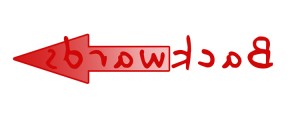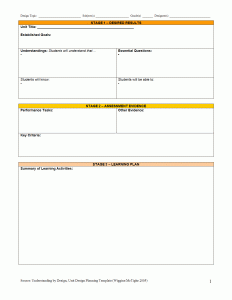Backward Design (Scholar Post)
A topic that I found interesting during our semester together was that of backward design. Teaching has evolved dramatically over the past few decades. It is becoming less about just “teaching” a subject, and more about making sure that your students understand what they are being taught, and why it is important to them when they graduate. This is largely due to more state and national standardized testing that students are required to take. Because of this, teachers are finding it difficult to plan for their classes. They want to make sure that students are getting the most out of what they’re required to learn.
We were first introduced to the idea of backward design in class during module 6 (class 4/13). I have heard about this approach in other classes, but I was learning about what it entailed. Now planning is going beyond just knowing what you’re teaching or what the state standards are for your subject. Now you need to know the knowledge of your students (Graff 2011). This is where we start to look at a great concept called curricular knowledge.
Curricular knowledge has two main parts. The first being horizontal, and the second is vertical. Graff does a great job at explaining these two types of knowledge. Horizontal entails the materials that students are studying in other classes, at the same time as your own. Vertical knowledge is the familiarity of what the students have already learned in your subject area, or what they are going to learn down the road (Graff 2011). Why is this important? Because to teach your students effectively you HAVE to understand what they already know, and what they don’t know. So after you have an understanding of where your students are, you can start to lesson plan. Backwards designing is just what it means, backwards planning. Where should a teacher start when creating a lesson plan that is backward?
The end goal of a backward design curriculum and instruction is for students to have a deeper understanding of what they’re learning along with retention and generalization (Chidre 2009). To ensure that this happens the way we would like it to there are specific steps that should be followed They include Identifying learners, identifying curricular priorities, design assessment framework, and create learning activities (Childre 2009).
Identifying learners is important for many reasons, but for your students to gain the most out of your class you need to understand their learning pattern. Do any of your students require special needs? Are any of your student’s ESL or ELL learners? After you have identified the learners individually it is important to identify your classroom needs as well. Are you more of a discussion based class? Or do you really like to lecture, and have the students note take? After you have assessed the learners you can move on to priorities.
Identifying curricular priorities is the second step. Here is where you will look at your state, and local standards. What is the knowledge that the children are supposed to gain out of your class by the end of the lesson? Other things that you could look at include are what your students should already know by the time they reach your classroom?
The third step is designing assessment framework. How are you going to get your students to learn what you want them to know? Childre (2009), explains “The aim is to move beyond recall of memorized facts to deeper understanding” (pg 9). This step helps you figure out how you want to test your students to make sure that they are gaining the knowledge you want them too. Will you quiz them? Have tests, or writing projects? The things you can do are really, endless. Once you have figured out you can get to the fun part, planning!
Step four is the part where you get to plan the activities for your students. This can be a fun, yet intimidating. Here I will bring in the template that we used in class.
As you can see, the template that we used in class really helps us get to the result we want for our students (class 4/13). The first thing that it asks the teacher to do is step one, which is the desired results. What are your goals? What do you want students to take away from your class? Then it goes into the understandings of the students. What do they already know? What do you want them to know? The second part of the lesson plan template allows you to plan for assessment. What will you have students do to show that they are learning the important information? What are other ways besides exams or projects that could show evidence? What criteria will the students be judged on? Lastly, you can use the large space to plan activities. These could include field trips, guided notes, and other fun activities to make the topic at hand interesting to learn. Along with this template, Wiggins (2012) does an awesome job at explaining why backward design is important in classrooms by having teachers continue to go back to their essential question, and make sure that they’re staying on track. He also has some great videos about creating a fantastic design for your classroom. Remember, Wiggins and McTighe (2005) explain that students are innocent of learning until they are proven “guilty” by the evidence the teacher uses.
In the end, I feel that backward design is one of the most effective ways to lesson plan. I really like starting with your goals, and explaining how you’ll get to them. Attached I have a video that does a really great job of showing why backward design can be important for every student!
References:
Childre, A., Sands, J. R., & Pope, S. T. (2009). Backward Design. Teaching Exceptional Children, 41(5), 6-14.
Graff, N. (2011). “An Effective and Agonizing Way to Learn”: Backwards Design and New Teachers’ Preparation for Planning Curriculum. Teacher Education Quarterly, 38(3), 151-168.
Wiggins, G., & McTighe, Jay. (2005). Understanding by design / Grant Wiggins and Jay McTighe. (Expanded 2nd ed.).
Wiggins Video: https://www.youtube.com/watch?v=WsDgfC3SjhM
Filed under Uncategorized | Comments (6)
Final Thoughts
It has been a great semester! I will be walking away with some great information, that I will be glad to carry into my future classroom.
When it comes to being a great educator there are a few things that I think are extremely important. First, creating relationships. You are the one driving force in that students life for 9 months out of the year, 8 hours a day, 5 days/week. You must understand that student in order to effectively teach them. The second thing would be communication. Communicate, communicate, communicate!!!! Communicate with not only the student, but the parents, principal, other teachers, and other people who interact with that child on a day to day basis such as before and after school staff (me). That way we can all work as a team to help that student succeed. One last thing that is important as an educator is student centered learning. No child wants to sit all day and listen to lecture. Take their opinions into consideration, and tweak your lesson plans to incorporate their ideas. Has my opinion changed since the beginning of the semester? No, not necessarily. It never changes, It just evolves and grows. Working with students daily also helps with this. I take what I learn in the classroom and apply it to my after school program, and I can’t wait to implement it into my classroom.
Looking back this course has helped me prepare for almost every single standard. However, the two that stick out to me would be standard 3 and standard 7.
Standard 3: Teachers understand that children learn differently…..
This was shown to us in module four dealing with learner diversity. No one student is the same, we all come from different backgrounds. As teachers we need to learn to adapt our classrooms to everyone. I feel that this can also go hand-in-hand with standard 7.
Standard 7: Teachers are able to plan different kinds of lessons…..
Since all students are different, and all students learn different we need to be able to make all of our students successful members of our classrooms. Some students are visual learners, while others are hands on learners that is why creating a variety of ways to learn a unit is important. Motivation and instruction in module five did a great job of teaching us ways to implement that into our classrooms someday.
Backward’s designing will be taken with me throughout my career. I love being able to start with the final objectives of what I want my students to know, and then deciding how I am going to get them to the end goal. I will continue to research this throughout my college career.
I believe that our blogs were one of the best assignments that we could do. It is important to get ourselves out there for other professionals to see. This can help us gain new ideas from people who have different experiences then us. I will continue to use this blog until I graduate, and even after to always stay up to date on new and improved classroom tips. Good luck, everyone!
Enjoy this cute clip I found about teachers who made a difference!
Filed under Uncategorized | Comments (5)

